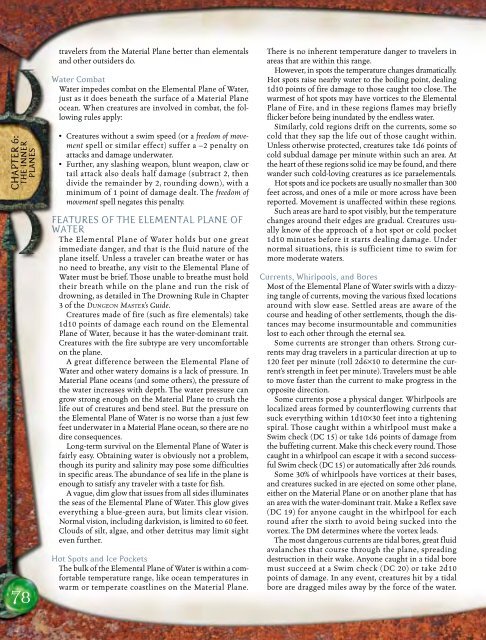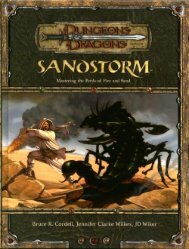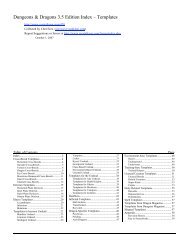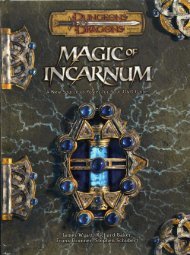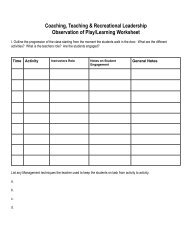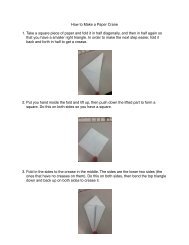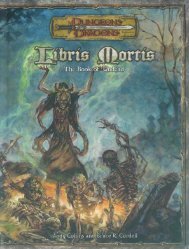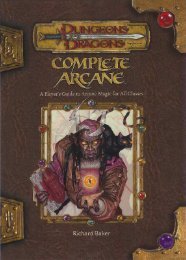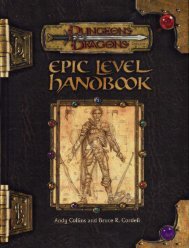CHAPTER 6:THE INNERPLANES78travelers from <strong>the</strong> Material Plane better than elementalsand o<strong>the</strong>r outsiders do.Water CombatWater impedes combat on <strong>the</strong> Elemental Plane <strong>of</strong> Water,just as it does beneath <strong>the</strong> surface <strong>of</strong> a Material Planeocean. When creatures are involved in combat, <strong>the</strong> followingrules apply:• Creatures without a swim speed (or a freedom <strong>of</strong> movementspell or similar effect) suffer a –2 penalty onattacks and damage underwater.• Fur<strong>the</strong>r, any slashing weapon, blunt weapon, claw ortail attack also deals half damage (subtract 2, <strong>the</strong>ndivide <strong>the</strong> remainder by 2, rounding down), with aminimum <strong>of</strong> 1 point <strong>of</strong> damage dealt. The freedom <strong>of</strong>movement spell negates this penalty.FEATURES OF THE ELEMENTAL PLANE OFWATERThe Elemental Plane <strong>of</strong> Water holds but one greatimmediate danger, and that is <strong>the</strong> fluid nature <strong>of</strong> <strong>the</strong>plane itself. Unless a traveler can brea<strong>the</strong> water or hasno need to brea<strong>the</strong>, any visit to <strong>the</strong> Elemental Plane <strong>of</strong>Water must be brief. Those unable to brea<strong>the</strong> must hold<strong>the</strong>ir breath while on <strong>the</strong> plane and run <strong>the</strong> risk <strong>of</strong>drowning, as detailed in The Drowning Rule in Chapter3 <strong>of</strong> <strong>the</strong> DUNGEON MASTER’s Guide.Creatures made <strong>of</strong> fire (such as fire elementals) take1d10 points <strong>of</strong> damage each round on <strong>the</strong> ElementalPlane <strong>of</strong> Water, because it has <strong>the</strong> water-dominant trait.Creatures with <strong>the</strong> fire subtype are very uncomfortableon <strong>the</strong> plane.A great difference between <strong>the</strong> Elemental Plane <strong>of</strong>Water and o<strong>the</strong>r watery domains is a lack <strong>of</strong> pressure. InMaterial Plane oceans (and some o<strong>the</strong>rs), <strong>the</strong> pressure <strong>of</strong><strong>the</strong> water increases with depth. The water pressure cangrow strong enough on <strong>the</strong> Material Plane to crush <strong>the</strong>life out <strong>of</strong> creatures and bend steel. But <strong>the</strong> pressure on<strong>the</strong> Elemental Plane <strong>of</strong> Water is no worse than a just fewfeet underwater in a Material Plane ocean, so <strong>the</strong>re are nodire consequences.Long-term survival on <strong>the</strong> Elemental Plane <strong>of</strong> Water isfairly easy. Obtaining water is obviously not a problem,though its purity and salinity may pose some difficultiesin specific areas. The abundance <strong>of</strong> sea life in <strong>the</strong> plane isenough to satisfy any traveler with a taste for fish.A vague, dim glow that issues from all sides illuminates<strong>the</strong> seas <strong>of</strong> <strong>the</strong> Elemental Plane <strong>of</strong> Water. This glow giveseverything a blue-green aura, but limits clear vision.Normal vision, including darkvision, is limited to 60 feet.Clouds <strong>of</strong> silt, algae, and o<strong>the</strong>r detritus may limit sighteven fur<strong>the</strong>r.Hot Spots and Ice PocketsThe bulk <strong>of</strong> <strong>the</strong> Elemental Plane <strong>of</strong> Water is within a comfortabletemperature range, like ocean temperatures inwarm or temperate coastlines on <strong>the</strong> Material Plane.There is no inherent temperature danger to travelers inareas that are within this range.However, in spots <strong>the</strong> temperature changes dramatically.Hot spots raise nearby water to <strong>the</strong> boiling point, dealing1d10 points <strong>of</strong> fire damage to those caught too close. Thewarmest <strong>of</strong> hot spots may have vortices to <strong>the</strong> ElementalPlane <strong>of</strong> Fire, and in <strong>the</strong>se regions flames may brieflyflicker before being inundated by <strong>the</strong> endless water.Similarly, cold regions drift on <strong>the</strong> currents, some socold that <strong>the</strong>y sap <strong>the</strong> life out <strong>of</strong> those caught within.Unless o<strong>the</strong>rwise protected, creatures take 1d6 points <strong>of</strong>cold subdual damage per minute within such an area. At<strong>the</strong> heart <strong>of</strong> <strong>the</strong>se regions solid ice may be found, and <strong>the</strong>rewander such cold-loving creatures as ice paraelementals.Hot spots and ice pockets are usually no smaller than 300feet across, and ones <strong>of</strong> a mile or more across have beenreported. Movement is unaffected within <strong>the</strong>se regions.Such areas are hard to spot visibly, but <strong>the</strong> temperaturechanges around <strong>the</strong>ir edges are gradual. Creatures usuallyknow <strong>of</strong> <strong>the</strong> approach <strong>of</strong> a hot spot or cold pocket1d10 minutes before it starts dealing damage. Undernormal situations, this is sufficient time to swim formore moderate waters.Currents, Whirlpools, and BoresMost <strong>of</strong> <strong>the</strong> Elemental Plane <strong>of</strong> Water swirls with a dizzyingtangle <strong>of</strong> currents, moving <strong>the</strong> various fixed locationsaround with slow ease. Settled areas are aware <strong>of</strong> <strong>the</strong>course and heading <strong>of</strong> o<strong>the</strong>r settlements, though <strong>the</strong> distancesmay become insurmountable and communitieslost to each o<strong>the</strong>r through <strong>the</strong> eternal sea.Some currents are stronger than o<strong>the</strong>rs. Strong currentsmay drag travelers in a particular direction at up to120 feet per minute (roll 2d6×10 to determine <strong>the</strong> current’sstrength in feet per minute). Travelers must be ableto move faster than <strong>the</strong> current to make progress in <strong>the</strong>opposite direction.Some currents pose a physical danger. Whirlpools arelocalized areas formed by counterflowing currents thatsuck everything within 1d10×30 feet into a tighteningspiral. Those caught within a whirlpool must make aSwim check (DC 15) or take 1d6 points <strong>of</strong> damage from<strong>the</strong> buffeting current. Make this check every round. Thosecaught in a whirlpool can escape it with a second successfulSwim check (DC 15) or automatically after 2d6 rounds.Some 30% <strong>of</strong> whirlpools have vortices at <strong>the</strong>ir bases,and creatures sucked in are ejected on some o<strong>the</strong>r plane,ei<strong>the</strong>r on <strong>the</strong> Material Plane or on ano<strong>the</strong>r plane that hasan area with <strong>the</strong> water-dominant trait. Make a Reflex save(DC 19) for anyone caught in <strong>the</strong> whirlpool for eachround after <strong>the</strong> sixth to avoid being sucked into <strong>the</strong>vortex. The DM determines where <strong>the</strong> vortex leads.The most dangerous currents are tidal bores, great fluidavalanches that course through <strong>the</strong> plane, spreadingdestruction in <strong>the</strong>ir wake. Anyone caught in a tidal boremust succeed at a Swim check (DC 20) or take 2d10points <strong>of</strong> damage. In any event, creatures hit by a tidalbore are dragged miles away by <strong>the</strong> force <strong>of</strong> <strong>the</strong> water.
Red TidesA dangerous contagion has infected patches <strong>of</strong> waterwhere red tides occur. Red tides range from a mere 60feet across to areas large enough to comprise entire seas<strong>of</strong> pestilence. Those who inhale <strong>the</strong> deadly water orwhose unprotected eyes are exposed to it may fall victimto blinding sickness, as described in Disease in Chapter 3<strong>of</strong> <strong>the</strong> DUNGEON MASTER’s Guide. Unlike with most diseases,<strong>the</strong> initial Fortitude save to avoid infection must bemade each minute a character remains in a red tide.Weeds and CoralBalls <strong>of</strong> seaweed and coral float through <strong>the</strong> ElementalPlane <strong>of</strong> Water, growing in all directions equally andresembling planets <strong>of</strong> living plant life. These sphericalbeds are <strong>of</strong>ten <strong>the</strong> lairs <strong>of</strong> outsiders native to <strong>the</strong> plane,especially tritons. The waters around weed and coralspheres frequently have excellent fishing grounds, sosometimes marids build outposts nearby.Marid CommunitiesMarids are a fiercely independent race, so <strong>the</strong> “maridempire” on <strong>the</strong> Elemental Plane <strong>of</strong> Water is really a largecollection <strong>of</strong> semi-independent strongholds, all <strong>of</strong> whichswear fealty in varying degrees to <strong>the</strong> padishah <strong>of</strong> <strong>the</strong>marid. Often that degree <strong>of</strong> fealty is determined by <strong>the</strong>proximity <strong>of</strong> <strong>the</strong> stronghold to <strong>the</strong> Citadel <strong>of</strong> Ten ThousandPearls or <strong>the</strong> presence <strong>of</strong> agents <strong>of</strong> <strong>the</strong> padishah. Allmarids claim nobility <strong>of</strong> some kind, and <strong>the</strong> plane is filledwith shahs, atabegs, and mufti.A typical marid stronghold is tied to some type <strong>of</strong>jetsam, usually a bit <strong>of</strong> solid matter or even a weed bed.Usually 2d10 marids are found in such a community,with a variety <strong>of</strong> elemental servants and jann, as well asmortals who have lost bets, sought favors, been chosen asfavorites. or o<strong>the</strong>rwise wound up enslaved by <strong>the</strong> (relatively)benign marids. They have little use for evil creatures,even those that brea<strong>the</strong> water, and marids are frequentlyat war with <strong>the</strong> evil denizens <strong>of</strong> <strong>the</strong> ElementalPlane <strong>of</strong> Water.The Citadel <strong>of</strong> Ten Thousand Pearls is <strong>the</strong> greatest <strong>of</strong>marid communities and <strong>the</strong> seat <strong>of</strong> <strong>the</strong> Coral Throne.From this court emanates <strong>the</strong> wise rulership <strong>of</strong> <strong>the</strong> GreatPadishah <strong>of</strong> <strong>the</strong> Marid, <strong>the</strong> Keeper <strong>of</strong> <strong>the</strong> Empire, <strong>the</strong> Pearl<strong>of</strong> <strong>the</strong> Sea, <strong>the</strong> Parent <strong>of</strong> <strong>the</strong> Waves, <strong>the</strong> Maharaja <strong>of</strong> <strong>the</strong>Oceans, Emir <strong>of</strong> All Currents, and so forth. This citadel, setatop a free-floating coral reef, is bedecked with all manner<strong>of</strong> towers and halls carved from living shell and ringedwith luminous, glowing pearls. About two hundred maridsmake <strong>the</strong> citadel <strong>the</strong>ir home, all <strong>of</strong> <strong>the</strong>m nobility. Eachmarid has a set <strong>of</strong> personal servants, bringing <strong>the</strong> nonmaridpopulation <strong>of</strong> <strong>the</strong> citadel to about a thousand.The court <strong>of</strong> <strong>the</strong> great padishah is filled with intrigueand espionage because each marid has <strong>the</strong> heartfelt beliefthat he or she truly deserves to sit atop <strong>the</strong> Coral Throne.Assassinations are common, as are palace revolutions andexiles. The marids are individually <strong>the</strong> most powerful <strong>of</strong>genies, but <strong>the</strong>ir strong wills and high opinions <strong>of</strong> <strong>the</strong>mselvesprevent <strong>the</strong>m from banding permanently underany one leader.City <strong>of</strong> GlassFor travelers with less <strong>of</strong> a taste for palace intrigue, <strong>the</strong>City <strong>of</strong> Glass is an ideal ga<strong>the</strong>ring spot on <strong>the</strong> ElementalPlane <strong>of</strong> Water (especially for travelers who brea<strong>the</strong> air).Located at a stable collection <strong>of</strong> portals to o<strong>the</strong>r planes(stable in that <strong>the</strong>y do not move in relationship to eacho<strong>the</strong>r), <strong>the</strong> City <strong>of</strong> Glass consists <strong>of</strong> a great sphere <strong>of</strong>unbreakable glass, half filled with water. Visitors enter<strong>the</strong> city through any number <strong>of</strong> openings along <strong>the</strong> waterside, or through magical portals in <strong>the</strong> air-bubble half.Many buildings cross <strong>the</strong> boundary between air andwater; <strong>the</strong>re are buildings filled with water in <strong>the</strong> air half,and buildings equally stocked with air beneath <strong>the</strong>water’s surface. By mutual agreement <strong>of</strong> <strong>the</strong> city’s resident,“down” is toward <strong>the</strong> water half <strong>of</strong> <strong>the</strong> sphere.The City <strong>of</strong> Glass is a cosmopolitan collection <strong>of</strong> traders,travelers, and expatriates from o<strong>the</strong>r planes. Its denizensare primarily from <strong>the</strong> aquatic races <strong>of</strong> <strong>the</strong> Material Plane,including merfolk, aquatic elves, kuo-toas, lizardfolk,locathahs, and sahuagin. It is ruled by a council <strong>of</strong> longtimeresidents, no two <strong>of</strong> whom may be <strong>of</strong> <strong>the</strong> same race.The City <strong>of</strong> Glass is a merchant’s freeport and activelyencourages trade. Mercanes may be found within its borders,along with marids, dao, and human traders. Several<strong>of</strong> its portals lead back to <strong>the</strong> Material Plane, and it is saidthat in secret places within <strong>the</strong> city, <strong>the</strong>re are portals too<strong>the</strong>r planes as well.Historians note that <strong>the</strong> “unbreakable” glass <strong>of</strong> <strong>the</strong> domehas been broken in <strong>the</strong> past. Without definite gravity, however,<strong>the</strong> air remained more or less where it was. The city<strong>of</strong>ficials immediately repaired <strong>the</strong> rift and put to death <strong>the</strong>visitors whose errant spells were responsible for <strong>the</strong> break.The AvengerThe true nature <strong>of</strong> <strong>the</strong> Avenger, a unique figure on <strong>the</strong>Elemental Plane <strong>of</strong> Water, is unrevealed. Considered amyth by many, <strong>the</strong> Avenger appears as a great, dark graymanta ray measuring about 90 feet from <strong>the</strong> nose to <strong>the</strong>base <strong>of</strong> <strong>the</strong> tail and 180 feet from wingtip to wingtip. Itstail, which extends a fur<strong>the</strong>r 90 feet, discharges lightningbolts (as an 18th-level sorcerer), apparently at will. TheAvenger appears to be a construct or a vehicle as opposedto a living beast, because it propels itself through <strong>the</strong>water with a battery <strong>of</strong> water-screws.There are several <strong>the</strong>ories about <strong>the</strong> Avenger. It mightbe a powerful construct, ei<strong>the</strong>r still under <strong>the</strong> control <strong>of</strong>its master, wild and berserk, or with its own free will—<strong>the</strong> stories inevitably vary on this point.O<strong>the</strong>rs contend that <strong>the</strong> Avenger is a vehicle, perhapsconstructed on an alternate Material Plane, that found itsway to <strong>the</strong> Elemental Plane <strong>of</strong> Water. The nature or fate <strong>of</strong>its crew varies from tale-spinner to tale-spinner as well.The locathahs say that <strong>the</strong> crew is locathah pirates, while<strong>the</strong> marids make a good case for rebellious jann. Severalhuman tales talk <strong>of</strong> a crew <strong>of</strong> spectres.CHAPTER 6:THE INNERPLANES79
- Page 2 and 3:
MANUAL OF THE PLANESJeff Grubb, Bru
- Page 4:
INTRODUCTIONIntroductionThis book i
- Page 7 and 8:
of the universe (earth, air, fire,
- Page 9 and 10:
within a plane where the rules are
- Page 11 and 12:
Shapes of the PlanesinfiniteGreat W
- Page 13 and 14:
save (DC 25) or gain a negative lev
- Page 15 and 16:
Illus. by A. Swekelven if a plane i
- Page 17 and 18:
Planar RelationshipsPlaneAPlane ACo
- Page 19 and 20:
Creatures that use positive or nega
- Page 21 and 22:
GETTING FROM PLANETO PLANEThe plane
- Page 23 and 24:
Illus. by A. Swekelhe planes are la
- Page 25 and 26:
Spot (Wis), and Use Magic Device (C
- Page 27 and 28: Direction (Wis), Jump (Str), Knowle
- Page 29 and 30: damage bonus does not apply to crea
- Page 31 and 32: to a limited extent. On planes with
- Page 33 and 34: Greater planar bindingHoly wordLess
- Page 35 and 36: elemental form to put out nonmagica
- Page 37 and 38: Audible Alarm: An audible portal al
- Page 39 and 40: On planes you create yourself, safe
- Page 41 and 42: Illus. by A. Swekelhe Material Plan
- Page 43 and 44: Oerth’s cosmology is laid out in
- Page 45 and 46: Illus. by A. Swekelhe Transitive Pl
- Page 47 and 48: spells and spell-like effects that
- Page 49 and 50: often used by astral travelers who
- Page 51 and 52: There is no day or night on the Ast
- Page 53 and 54: Table 5-3: Astral Encountersd% Enco
- Page 55 and 56: try to lure adventurers away from e
- Page 57 and 58: even if prisoners escape, they’re
- Page 59 and 60: Any creature becoming ethereal (inc
- Page 61 and 62: The Plane of Shadow does not connec
- Page 63 and 64: describes some typical abilities an
- Page 65 and 66: Illus. by A. Swekelhe Inner Planes
- Page 67 and 68: positiveElementalPlane ofWaterThree
- Page 69 and 70: A maximum of 20d6 points of damage
- Page 71 and 72: of material and have his life crush
- Page 73 and 74: Table 6-2: Elemental Plane of Earth
- Page 75 and 76: MOVEMENT AND COMBATThe Elemental Pl
- Page 77: ELEMENTAL PLANEOF WATERIt is an oce
- Page 81 and 82: • Impeded Magic: Spells and spell
- Page 83 and 84: Class abilities that use positive e
- Page 85 and 86: Illus. by A. Swekelf the Inner Plan
- Page 87 and 88: CHAPTER 7:THE OUTERPLANES87Beastlan
- Page 89 and 90: everything within a ten-mile radius
- Page 91 and 92: Only those who suffer mortal wounds
- Page 93 and 94: Plane drift through the miasma: bit
- Page 95 and 96: FamiliarityVery familiarStudied car
- Page 97 and 98: Every word, scream, or shout is cau
- Page 99 and 100: oulders, and worked stone, as if a
- Page 101 and 102: directional gravity. Unless stated
- Page 103 and 104: sun no brighter than the Material P
- Page 105 and 106: and Colothys confines liars whose u
- Page 107 and 108: OthrysCathrysMinethysColothysPorpha
- Page 109 and 110: Normal petitioners in Hades gain on
- Page 111 and 112: PlutonThe third gloom of Hades is a
- Page 113 and 114: Gehenna CombatCombat on Gehenna is
- Page 115 and 116: NINE HELLS OF BAATORIt is Hell, whe
- Page 117 and 118: added to the Bronze Citadel. Work g
- Page 119 and 120: dribble of slimy water sluices into
- Page 121 and 122: StygiaThe fifth layer of the Nine H
- Page 123 and 124: they first enter the downdraft or b
- Page 125 and 126: are big enough for whole cities and
- Page 127 and 128: the truth, the ice sheet has object
- Page 129 and 130:
Scion Queen Mother at all times, an
- Page 131 and 132:
they have three possible courses of
- Page 133 and 134:
always find themselves in the surf
- Page 135 and 136:
amid treasure gathered over eons—
- Page 137 and 138:
BYTOPIA INHABITANTSBytopia is home
- Page 139 and 140:
on the Material Plane, sounds more
- Page 141 and 142:
BelierinBelierin is a land of misty
- Page 143 and 144:
without touching the ground. The Be
- Page 145 and 146:
ARBOREA LINKSArborea borders the Be
- Page 148 and 149:
CHAPTER 7:THE OUTERPLANESOUTLANDS I
- Page 150 and 151:
OutlandsExcelsiorSigilTradegateEcst
- Page 152 and 153:
CHAPTER 7:THE OUTERPLANES152Table 7
- Page 154 and 155:
CHAPTER 8:DEMIPLANES154to multiple
- Page 157 and 158:
of naivete. Neth doesn’t know how
- Page 159 and 160:
Illus. by A. Swekelhe planes suppor
- Page 161 and 162:
BARIAURMedium-Size OutsiderHit Dice
- Page 163 and 164:
precious and lovely, firres take up
- Page 165 and 166:
Summon Tanar’ri (Sp): Tanar’ri
- Page 167 and 168:
Spinagon (Baatezu)Narzugon (Baatezu
- Page 169 and 170:
Xag-YaXeg-YiMedium-Size Outsider (I
- Page 171 and 172:
dull black orbs that reflect noligh
- Page 173 and 174:
DaoMaridLarge Outsider (Air, Evil)L
- Page 175 and 176:
is drawn in melee, the blade transf
- Page 177 and 178:
When an inevitable is created, it r
- Page 179 and 180:
matter at hand. They use alter self
- Page 181 and 182:
Ice Paraelemental, Small Ice Parael
- Page 183 and 184:
Magma Paraelemental, Huge Magma Par
- Page 185 and 186:
succeed at a Fortitude save or inha
- Page 187 and 188:
CanolothMezzolothMedium-Size Outsid
- Page 189 and 190:
strange and often distasteful rites
- Page 191 and 192:
Climate/Terrain: Any land and under
- Page 193 and 194:
Elemental: Immune to poison, sleep,
- Page 195 and 196:
Skills: Water element tigers receiv
- Page 197 and 198:
Damage: Bite 1d6+3, claw 1d3+1; spi
- Page 199 and 200:
Alignment: Always chaotic (any).Adv
- Page 201 and 202:
Appendix: VariantPlanes & Cosmologi
- Page 203 and 204:
Region of DreamsDreamscapesDreamsca
- Page 205 and 206:
A mirror-self is created somewhere
- Page 207 and 208:
ever-shifting ice floating on a fro
- Page 209 and 210:
Time onTime ond% Material Plane Tem
- Page 211 and 212:
FAERIE INHABITANTSThe Plane of Faer
- Page 213 and 214:
are needed to swim through it. Movi
- Page 215 and 216:
Myriad PlanesCosmologyplanar clumpp
- Page 217 and 218:
sends that character’s double fro
- Page 219 and 220:
WINDING ROAD LINKSPlanar travelers
- Page 221 and 222:
Planar Rips: Planar rips are holes
- Page 223:
Lolth 100, 103Lucid Dreaming 203Lun
- Page 226 and 227:
Table 1: Modron CastesCaste No. of
- Page 228 and 229:
4pursuit of order is particularly b
- Page 230 and 231:
THE MODRONCATHEDRALDeep in the hear
- Page 232 and 233:
drones have limited conversational
- Page 234 and 235:
10tually any environment, withstand
- Page 236 and 237:
12Modron Traits: Immune to mind-inf
- Page 238 and 239:
Face/Reach: 5 ft. by 5 ft./10 ft.Sp
- Page 240 and 241:
16Spell-Like Abilities: At will—c
- Page 242 and 243:
Wholeness of Body (Su): A secundus
- Page 244 and 245:
2of the common room into other part
- Page 246 and 247:
credence to this theory by occasion
- Page 248 and 249:
PLAY MOREFREE D&D® V.3.5 ACCESSORY
- Page 250 and 251:
Table of ContentsThe Nature of the
- Page 252 and 253:
Pandemonium: Electricity and sonic
- Page 254 and 255:
Manual of the Planes MonstersFeats


